| Designation: | STRYKER XM1128 MGS |
 |
|---|---|---|
| Manufacturer: | General Dynamics Land Systems - GDLS | |
| Product type: | Armoured Vehicles | |
| Name: | Fire support vehicle |
The 105 mm Low Profile Target (LPT) Assault Gun was developed by the now General Dynamics Land Systems - Canada as a private venture to meet future requirements for an airmobile 105 mm weapon system.
The first prototype of the 105 mm LPT Assault Gun was completed in 1999.
The system essentially consists of the latest production standard General Dynamics Land Systems - Canada Stryker (8 × 8) chassis fitted with the private venture General Dynamics Land Systems Low-Profile Turret (LPT), which has already been installed on a number of other platforms for trials purposes.
The vehicle has been designed to be air portable in a number of transport aircraft including the C-5A, C-17, C-130 and C-141. Similar to recent versions of the LAV on which it is based, the 105 mm LPT is not amphibious, although it can ford to a depth of 1.7 m.
Following a competition, late in 2000 the US Army selected a version of this system based on a LAV-III (8 × 8) chassis to meet its requirement for a Mobile Gun System (MGS) for use with its new Brigade Combat Teams.
The first of eight preproduction MGS was delivered to the US Army in July 2002. These preproduction MGS were assembled at the General Dynamics Land Systems Muskegon technology centre.
The vehicles were built using USD62 million in research and development funding of the original USD4 billion contract and all were completed by the end of 2002.
In US Army service the LAV-III has been named Stryker. It is expected that 204 MGS will be procured by the US Army.
Under current plans it is expected that each Interim Brigade Combat Team (IBCT) will have a total of 31 MGS. These will be issued on the scale of three MGS per platoon. Each infantry battalion will have one company of three MGS platoons making for a scale issue of 9 MGS per battalion. Each IBCT will have three infantry battalions with a total of 27 MGS plus an Operational Readiness Float (ORF) of four, to give a total of 32 MGS per IBCT.
The 105 mm Mobile Gun System is now in production for the US Army under the designation of the M1128 with first systems deployed to Iraq in early 2007.
The Canadian Army had a requirement for a total of 66 MGS to replace its current fleet of 105 mm armed Leopard 1 MBTs.
In early 2007 a decision was made by Canada to cancel the acquisition of 66 MGS and instead procure Leopard 2 MBTs.
The first of these, Leopard 2A6M CAN, was handed over to the Canadian Army late in July 2007. These are upgraded German Army Leopard 2A6M with a number of enhancements including slat armour for deployment to Afghanistan.
The hull of the 105 mm LPT Assault Gun is of all-welded steel armour construction to which an additional layer of passive armour has been added to provide a higher level of protection.
The passive armour package depends on the user but typically would provide protection against 12.7 mm armour piercing (AP) at specified ranges. For its new role, the LAV-III (8 × 8) chassis has been modified in a number of areas. These include a new lower top deck, new rear wall and hull, new race ring support for the turret, manual up-load hatch in rear side of roof, winch and winch cover and revised engine cooling and exhaust grills.
For crew protection against ballistic overmatch situations, the vehicle is also equipped with a liner of composite material applied to selected portions of the interior of the vehicle. This liner minimises spalling in the event of hull penetration.
The driver is seated at the front of the vehicle on the left side and can enter his position via a single-piece hatch cover that opens to the rear, or via the crew compartment.
In the forward part of the driver's hatch cover are three M17 day periscopes, the centre one of which can be replaced by an image intensifier for night driving. The hatch provides single eye-level viewing for the driver for both the hatch open and closed positions. A thermal viewing aid can also be inserted up through the hull ahead of the driver's hatch for driving at night.
The power pack is to the right of the driver and is provided with an automatic fire detection and suppression system. The prototype vehicle was fitted with a Caterpillar 3126A diesel engine is coupled to an Allison MD 3560 P automatic transmission with six forward and one reverse gears and a two speed transfer case.
Steering is power-assisted on the front two axles and when driven across country, all eight wheels are engaged. When being driven on roads the front four wheels are normally disengaged.
A central tyre pressure-regulation system is fitted as standard and this allows the driver to adjust the tyre pressure to suit the type of terrain being crossed.
The power-operated LPT is mounted in the rear section of the hull with the gunner being seated on the left and the vehicle commander on the right.
The LPT is not only much lighter than a conventional turret armed with a 105 mm rifled tank gun, but also presents a much smaller turret to the enemy. This makes it more difficult to locate and therefore more difficult to successfully engage.
Turret traverse is all solid-state digital electric with manual controls as a back up. Turret traverse is a full 360° with 105 mm weapon elevation from -8 to +18°. Either the commander or gunner can lay and fire the 105 mm main armament, both having identical controls.
The gunner has a roof-mounted two-axis stabilised day/thermal sighting system that includes a laser range-finder.
In addition, the gunner has three M27 day periscopes that give observation to the front, sides and rear and a single-piece hatch cover. There is also an auxiliary day sight with a magnification of ×7 that can be used by the commander or gunner, which is mounted to the right of the 105 mm M68A2 gun and linked mechanically to the gun.
The commander has six M27 wide field of view day periscopes that give observation to the front, sides and rear and a two-axis stabilised panoramic viewer (planned for production) that is mounted on the right side of the LPT. This has a low-light level television and variable field of view day optics.
This has been developed from the system installed on the US Marine Corps General Dynamics Expeditionary Fighting Vehicle (EFV). In addition, the commander has a screen on which he can see a picture from his own sighting system as well as that of the gunner.
The 105 mm M68A2 rifled gun is based on the M68A1 barrel but now has an integrated pepperpot muzzle brake, muzzle reference system, standard bore evacuator and a thermal sleeve. It should be noted that its primary role is to support infantry, not engage threat armoured fighting vehicles.
Following a competition, the US L3 Communications company was awarded a contract by the US Army for the development and production of the enhanced 105 mm HEP-T and associated training round M467 TP-T (Target Practice - Tracer) for use by the MGS.
The BT Fuze Products Division of L3 Communications is the overall prime contractor, and supplies the M578E1 fuze for the M393E3 HEP-T round. The division developed the Technical Data Package (TDP) for the M578E1 fuze, while MECAR developed the TDP for the M393E3 and M467 rounds.
The multiyear US Army contract covered Low Rate Production (LRP) and Full Rate Production (FRP), which has now started at the MECAR facility in Belgium. The total programme value is USD28.4 million, which covers the supply of 10,000 combat and 18,400 training rounds for delivery over a four-year period, plus options.
The LRP part of the contract was completed early in 2004 and covered the supply of 1,100 M393E3 and 2,400 M467 rounds. The M393E3 has been type classified as the M393A3.
The original HEP-T M393 round was optimised for use against armoured targets, while the latest generation M393A3 is optimised for the bunker-busting mission that is the prime mission of the MGS.
The primary role of the M393A3 is the defeat of targets by direct fire in support of dismounted infantry operations. The round must defeat a double-reinforced concrete wall, a standard infantry bunker and infantry units.
For training, the TP-T M467 is being procured, which is a ballistic match for the M393A3. This is an inert round that uses the same propellant, tracer and primer as the combat round.
The 105 mm M68A2 gun is fed by a hydraulically operated loader mounted in the turret basket which contains eight rounds of ready-to-use 105 mm ammunition. The empty cartridge cases are ejected out of the rear of the Low Profile Turret bustle.
A load cycle takes 6 seconds and the loader can download ammunition as well as uploading under power or manual control. A typical ammunition load would be 24 to 32 rounds of 105 mm of ammunition. There is also the option of revolver type automatic 105 mm ammunition reloading system which would feed the ready use magazine.
A 7.62 mm machine gun is mounted coaxial to the left of the 105 mm M68A2 gun and a 7.62 mm machine gun can be mounted on a skate mount at the commander's station. Mounted on either side of the LPT, at the rear, is a bank of four M6 66 mm electrically operated smoke grenade launchers.
The crew can also enter their positions via the twin doors in the hull rear, or via hatches in the roof.
The heart of the computerised fire-control system is the General Dynamics Canada fire-control computer. The identification of the target is primarily done by the commander looking through the day periscopes around his hatch, using the panoramic camera, or by viewing the same image that the gunner is seeing though his/her day sight or thermal imager.
The usual combat scenario is that the commander will locate the target and then hand off to the gunner; the commander is then free to locate another target.
The commander can also override the gunner's controls and engage targets. As the sights and 105 mm M68A2 gun are fully stabilised, the system has a high hit probability against stationary and moving targets while the vehicle is stationary or moving.
Typical equipment on the base vehicle includes an anti-tank guided missile wire cutter for the hull and turret, a climate control system comprising a heating and air conditioning system, vehicle and external communications systems, crew compartment fire detection and suppression system, a slave receptacle and an inter-linked global positioning system.
If required, the 105 mm LPT Assault Gun can be fitted with an Auxiliary Power Unit (APU) and/or a hydraulically operated winch mounted on the left side of the vehicle behind the driver's hatch that leads out through the front or rear of the vehicle. This can be used for self-recovery or to recover other moved or disabled vehicles.
|
||||||||||||||
|
||||||||||||
|
|||||||||||||||||||||||||
All contracts...
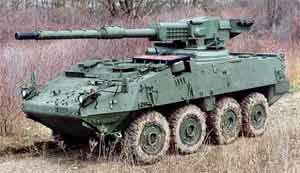 |
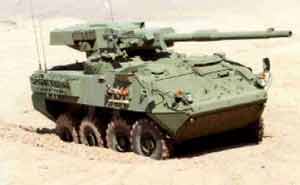 |
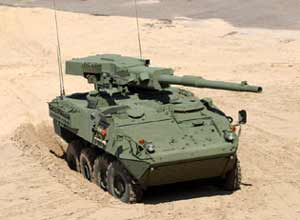 |
 |
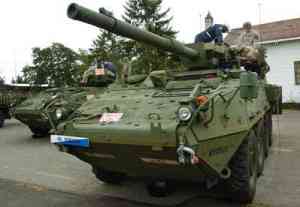 |
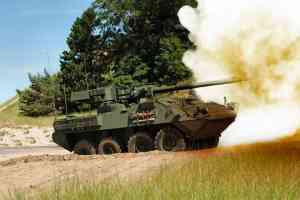 |
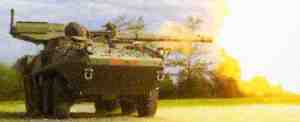 |
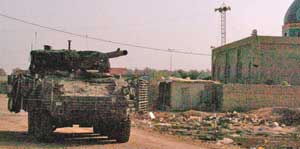 |
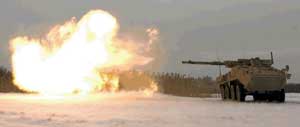 |


